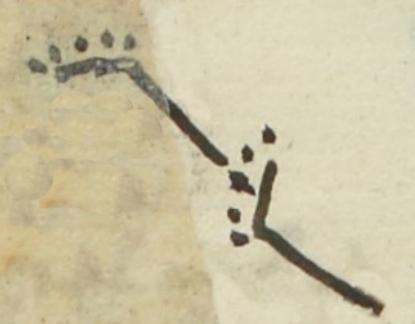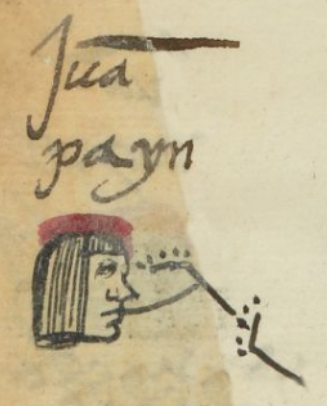Pain (MH498v)
This black-line drawing of the simplex glyph for the personal name Pain ("He Ran Fast," attested here as a man's name) shows a bird's eye view of two footprints on a diagonal, going upward and to the viewer's left. At the bottom is the left footprint, and at the top is the right footprint. Each footprint has five toe prints (dots).
Stephanie Wood
The alternation of the footprints creates a sense of movement across a landscape. The speed of the movement, which is part of the name, is not shown visually. See another glyph, below, for Yaopain, a combatant who runs fast.
Footprint glyphs have a wide range of translations. In this collection, so far, we can attest to yauh, xo, pano, -pan, paina, temo, nemi, quetza, otli, iyaquic hualiloti, huallauh, tepal, tetepotztoca, totoco, otlatoca, -tihui, and the vowel "o." Other research (Herrera et al, 2005, 64) points to additional terms, including: choloa, tlaloa, totoyoa, eco, aci, quiza, maxalihui, centlacxitl, and xocpalli.
Stephanie Wood
Juā
payn
Juan Pain
Stephanie Wood
1560
Jeff Haskett-Wood
runs, corre, huellas, pies, pasos, steps, icximachiyotl, xocpalli, icxipamitl, feet, correr rápido, nombres de hombres

paina, to run fast, https://nahuatl.wired-humanities.org/content/paina
Corrió Rápido
Stephanie Wood
Matrícula de Huexotzinco, folio 498v, World Digital Library, https://www.loc.gov/resource/gdcwdl.wdl_15282/?sp=76&st=image
This manuscript is hosted by the Library of Congress and the World Digital Library; used here with the Creative Commons, “Attribution-NonCommercial-ShareAlike 3.0 License” (CC-BY-NC-SAq 3.0).




